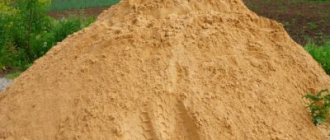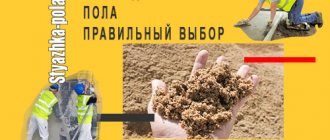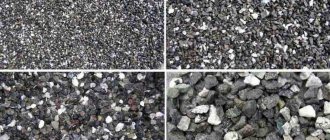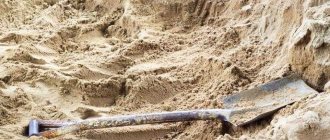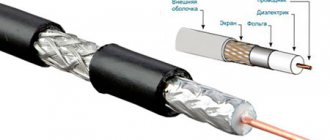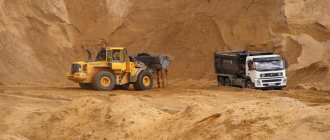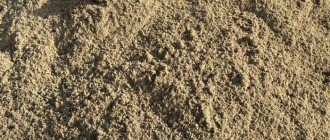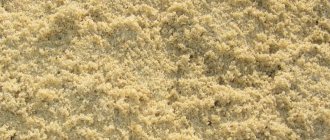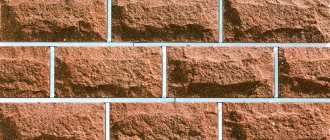Looking at a pile of sand brought to a site, two builders will behave differently.
The newcomer will cast an indifferent glance at her and take up the shovel.
An experienced builder will first take a handful of sand, look at it carefully and rub it in his palms. After that, he will give a verdict: it’s suitable for concrete, but not suitable for plaster and masonry.
What is the secret of construction sand that requires such careful evaluation? We will examine this issue in more detail.
Physical and mechanical characteristics
Volume weight
It shows the mass of 1 m3 of sand in its natural state (wet, with all impurities). On average, the volumetric weight of this material ranges from 1500 to 1800 kg.
The composition of construction sand is assessed according to the following parameters:
- Granulometric;
- Mineral;
- Chemical.
Granulometric shows the percentage of grains of different sizes. To determine it, sand is sifted through calibrated sieves (from 0.16 mm to 10 mm).
A sieve with aperture sizes of 5 and 10 mm reveals gravel granules. GOST allows the presence of grains measuring 1 cm. However, their quantity should be no more than 0.5% of the total mass of sand.
Granules larger than 5 mm are normalized as follows:
- Maximum content - up to 10% in natural;
- up to 15% in crushed;
- up to 5% in enriched sand.
Mineral composition
Based on mineral content, sands are divided into quartz, dolomite, feldspathic and limestone. Quartz sand is the most valuable for construction, since other types are not strong enough and are not resistant to chemical influences.
Chemical composition
It plays an important role in determining the suitability of bulk material in various fields of construction. Red, yellow, and orange shades indicate the presence of oxidized metals. Green and blue colors are characteristic of river sand, which contains aluminum salts.
What should sand be like for a sandbox?
There are four main criteria that determine which sand is best for a sandbox
Size. The optimal diameter of sand grains is 1-3 mm. Larger ones will be inconvenient for playing, while smaller ones will easily rise into the air, creating excess dust. The latter are dangerous to the child’s health, as they can settle in the lungs and lead to various diseases. The absence of dust particles is the main difference between baby sand and construction sand. We recommend choosing a homogeneous material - it molds better.Cleanliness
It is especially important to ensure that there is no waste when purchasing material of river origin. It may contain sharp-edged shells, needle stones, sulfur
The material must go through at least two stages of processing - washing and calcination. Certification. Most properties can be verified by examining the material certificate. If the seller does not have such documentation, it is better to refuse the purchase. Certificates must indicate that the sand is intended for children's play. This means that the product has passed all the necessary tests, is not radioactive, and does not contain toxic substances. Color. In nature, sand is light brown, maybe with a yellow or reddish tint. Other differences in color indicate unwanted impurities and may be dangerous for the child. If you ask children what kind of sand is best for a sandbox, the answer will definitely be colored. Materials with safe dyes will help diversify the game. Manufacturers offer all the colors of the rainbow!
When purchasing, you need to check the material for moisture content. Under no circumstances should you settle for wet or damp sand. After drying, it may not meet the declared properties.
It is better to purchase sand in bags. You need to ensure the integrity of the packaging. This will be an additional guarantee that the sand is not old and all rules for its storage and transportation are followed.
Types of construction sand
The classic definition is that sand is a mixture of mineral particles (quartz, mica, limestone) formed as a result of natural or artificial destruction of rocks.
GOST 8736-93 lays out the most important properties of sand “on the shelves” . According to this standard, sand is divided into two classes:
- Class I - very coarse, then comes sand of increased coarseness, coarse, medium and fine;
- Class II - very large, extra large, large, medium, small, very small, thin and very thin.
The main difference between these classes is that lower quality sand (second class) includes three additional fractions. Fine dust particles are an undesirable component of mortars. They impair the bond between the large sand granules that the cement binds.
Next, GOST contains a table in which construction sand is divided into groups according to fineness modulus (mm).
| Sand group | Size module Mk |
| Very large | St. 3.5 |
| Increased size | 3.0 to 3.5 |
| Large | 2,5-3,0 |
| Average | 2,0-2,5 |
| Small | 1,5-2,0 |
| Very small | 1,0-1,5 |
| Thin | 0,7-1,0 |
| Very thin | Up to 0.7 |
In real production there is no such fine gradation.
Here the extracted sand is conventionally divided into three fractions:
- 0.5-1 mm – small;
- 1.5-2 mm – average;
- 2.5-3.5 mm – large.
Sands with a particle size modulus of 2-2.5 mm are used for the production of concrete and reinforced concrete structures. Bulk material measuring 1.5-2 mm is used for making bricks. The finest sand is used for preparing dry construction mixtures.
Having taken note of the GOST classification, let’s move on to the practical aspects of the origin and use of construction sand.
Based on the type of production, they are distinguished:
- Career;
- River;
- Nautical;
- Quartz (artificial) sand.
Construction sand
Natural sand is a loose loose rock of sedimentary origin, has a crystalline structure with a grain size of up to 5 mm and consists of destroyed mineral residues, most often quartz with a small amount of other inclusions.
Requirements for it as a building material, according to GOST 8736-93, include such parameters as grain size, its bulk and true density, the permissible limit for the content of dust and clay particles, harmful impurities, and radionuclides.
river sand
River sand is mined from river beds. It has a uniform consistency, good fluidity, and an average granule size in the range of 1.5–2.5 mm. Thanks to long-term natural washing, it is clean, the grains have the correct rounded shape.
It is believed that this is the highest quality filler for concrete mortar, the strength of which is especially important when constructing load-bearing structures. The advantages of the material, as a rule, include the following features.
- It does not contain clay and silt particles, which are unacceptable in cement-sand mortars and deteriorate their quality.
- The oval-shaped crystals do not become compacted during the preparation of the concrete mixture, the cement laitance evenly envelops them, and the finished concrete practically does not shrink.
River sand
It also has disadvantages.
- Mixing with this type of aggregate requires more cement and more thorough mixing.
- This is the most expensive of construction sands.
Quarry sand
The most common and affordable concrete filler. There are quarries with its development everywhere, manufacturers abundantly saturate the market with inexpensive and in-demand products.
Unlike its river counterpart, quarry sand has a wider range of fractions; its granules are irregularly shaped and angular. Contains a fairly large percentage of impurities, including dust, organic matter, clay, and rock fragments.
There are several ways to enrich it.
The washed (alluvial) product is obtained using the technology of special directed hydraulic influence on the rock mass with its subsequent settling. As a result, removal of foreign substances, primarily clay deposits, occurs.
The second method of enrichment is sifting through a system of sieves that retain large fragments of stones, lumps of clay, etc.
Sand quarry development
Despite the fact that quarry sand is inferior in quality to river sand, it is in demand in the construction industry and has a number of advantages.
- Much more common.
- Less cement is used to prepare concrete - this is due to the property of irregularly shaped crystals to compact more strongly.
- It has an attractive price.
- The enriched product meets the highest standards.
Among the disadvantages, experienced builders note the following.
- Quarry sand contains a higher percentage of organic clay and silty particles - up to 7% versus 0.05% in its river counterpart.
- Due to its structural composition, it settles and becomes compacted at the moment the concrete sets and hardens. The finished structure shrinks up to 1 mm per 1 cm.
Career
The name clearly indicates the origin of the sand. It contains clay and stones, so quarry material is used to a limited extent: for site planning, backfilling under concrete screeds or foundations.
To improve its properties, quarry sand is washed with water right at the mining site, freeing it from dust particles and clay. This is how alluvial (washed) sand is obtained. It is suitable for plastering and masonry mortars. In addition, sifting through sieves can be used to remove clay.
An important practical conclusion: if you are offered to buy quarry (gully) sand, do not forget to check whether it has been cleaned (washed, sifted) or not.
Areas of application of washed (sifted) quarry sand:
- cement screed, masonry and plaster mortars;
- Finishing work;
- brick production;
- foundation installation;
- preparation of concrete.
river sand
This building material is extracted by a dredger from the river bottom. There are no clay particles and very few stones in river sand. This allows you to use it for concrete work without restrictions.
It is very valuable that medium-sized river sand (1.8-2.2 mm) practically does not shrink. This makes it ideal for masonry and plastering.
Quarry sand is more difficult to use in this capacity. In the solution it settles to the bottom and has to be stirred periodically.
Areas of application of river sand:
- concrete production;
- brick production;
- masonry work and cement screed;
- preparation of asphalt concrete;
- drainage device;
- filler for paints and grouts.
Sea sand has similar properties to river sand. It is also highly valued in construction for its high purity and uniformity of particle size distribution.
Quartz sand
This material is obtained by mechanical crushing of quartz-containing rocks. It is homogeneous in structure, chemically inert and pure.
The main area of application of this type of sand is the construction materials industry. It goes into dry building mixtures, sand-lime bricks, blocks and concrete, and is used to prepare grinding compounds. Landscape design, expensive interior and facade plasters also cannot do without quartz sand.
It is impossible to unequivocally answer the question which sand is better , since each material is intended for certain types of work.
Still, the main conclusions are already obvious:
- for brick and large-block masonry, it is better to take river sand. If you mix it with a small amount of unwashed quarry sand, the solution will become more plastic (due to clay particles);
- for concrete, coarse or medium river sand is better suited (you can add a little fine washed quarry sand to it);
- For plaster, washed quarry sand with or without a small addition of river sand is better suited.
River and quarry sand - advantages and differences
Both quarry and river sand are natural bulk mixtures, equally in demand in construction, in the process of making bricks and concrete compositions.
The indicators of quarry and river sand according to GOST standards are almost identical. However, the difference in location and methods of extracting quarry and river sand predetermine the difference in their areas of application.
The sand, extracted from the bottom of rivers using modern high-tech hydraulic equipment, is perfectly clean. It may contain a certain amount of tiny particles of gravel (depending on the geography of where the sand rises), but the presence of litter and natural impurities, primarily clay, is reduced to zero.
Quarry - unrefined - sand, on the contrary, is highly clayey. Note that this is not always a disadvantage: in some cases, the specifics of preparing the target mortar for construction or finishing work require enhanced adhesive ability and high elasticity of the resulting mixture - here the high clay content comes in handy.
Approximate prices
Obviously, the cost of sand is higher, the more manipulations had to be done with it during extraction and cleaning.
The cheapest is quarry unwashed and unsown. Its price per cube ranges from 300 to 400 rubles. Quarry sand purified by water or sifting for construction work will cost from 550 to 700 rubles per 1 m3 with delivery.
River sand is significantly more expensive than quarry sand. Its price starts at 750 rubles and ends at 950 rubles/m3.
Fractionated quartz sand is the most expensive. When purchasing from 10 tons (1 KAMAZ), its price with delivery is from 4,500 rubles per cubic meter.
